The fish oil alternatives market is projected to grow from USD 2.8 billion in 2025 to around USD 4.6 billion by 2035, reflecting a steady CAGR of 5.0%.
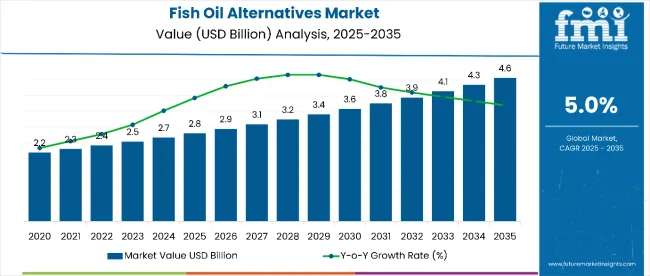
| Metric | Value |
|---|---|
| Estimated Market Value (2025E) | USD 2.8 billion |
| Forecast Market Value (2035F) | USD 4.6 billion |
| Forecast CAGR (2025 to 2035) | 5.0% |
This growth is supported by key markets including China, India, Japan, Germany, and the USA, with China leading at a CAGR of USD 6 billion followed closely by India at USD 5.8 billion. Among the products, chia seeds oil holds a significant share of 35%, with other important alternatives including soybean oil, canola oil, hemp seed oil, algae oil, walnut oil, and flaxseed oil.
By 2030, the market is likely to reach approximately USD 3.6 billion, representing an incremental absolute dollar growth of USD 0.8 billion over the period from 2025 to 2030. This includes about USD 0.3 billion in growth during the first half and USD 0.5 billion in the second half, highlighting a back-loaded growth pattern. Innovation in product development, such as improved extraction methods and enhanced bioavailability through advanced formulations, is gaining traction. These innovations support better nutritional absorption and integration, driving demand across food, nutraceutical, and pharmaceutical applications in the fish oil alternatives sector.
Companies such as Cargill Incorporated and Wilmar International are advancing their competitive positions in the market by investing in innovative extraction technologies and scalable production systems. These strategic moves are enabling expansion into fast-growing segments such as plant-based nutraceutical formulations, specialized food and beverage applications, and premium cosmetic products. Market performance in this sector will continue to be driven by adherence to stringent regulatory standards, a focus on product purity, and sustainable sourcing practices that meet the expectations of health-conscious consumers and institutional buyers.
The market holds a significant position within the broader natural oils market, driven by growing consumer demand for sustainable, plant-based omega-3 sources and increasing applications across food, nutraceutical, and cosmetic sectors. It plays an important role in the functional lipids market by providing alternatives that support cardiovascular health, cognitive wellness, and anti-inflammatory benefits. The market also contributes notably to specialty ingredients used in dietary supplements and pet food additives. Furthermore, fish oil alternatives are increasingly incorporated in pharmaceutical and nutraceutical formulations due to their favorable purity, bioavailability, and safety profiles.
The market is undergoing transformation fueled by advances in extraction technologies and enhanced processing methods that improve product quality, stability, and bioactivity. Manufacturers are launching standardized formulations suited for diverse applications, expanding beyond traditional food and beverage uses into premium nutraceuticals and pharmaceuticals. Strategic partnerships between ingredient suppliers and health-focused companies are accelerating innovation and market penetration. Regulatory compliance, sustainability standards, and quality certifications are shaping supply chains and supporting premium product positioning in global markets.
Fish oil alternatives are gaining traction due to their sustainable sourcing, high nutritional value, and suitability as plant-based omega-3 sources. These alternatives provide a cleaner, more environmentally friendly option compared to traditional fish oil, appealing to the growing number of health-conscious and vegan consumers. The market is further driven by increasing awareness of natural and functional ingredients in food, nutraceutical, and cosmetic applications.
Innovations in extraction and purification technologies are improving product quality, bioavailability, and versatility, enabling broader use in supplements, functional foods, and specialty personal care products. As the global emphasis on sustainable and clean-label products intensifies, the demand for fish oil alternatives continues to rise. The market outlook remains positive as manufacturers and consumers prioritize efficacy, purity, and environmental responsibility, supporting expansion across pharmaceutical, nutraceutical, food, and cosmetic sectors.
The market is segmented by product, application, distribution channel, and region. By product, the market is categorized into chia seeds oil, soybean oil, canola oil, hemp seed oil, algae oil, walnut oil, flaxseed oil, and others (specialty seed oils and blended oils). Based on application, the market is divided into food and beverage industry, cosmetics and personal care, animal feed, pet food additive, pharmaceuticals, nutraceuticals, and biofuels. In term of distribution channel, the market is bifurcated into B2B, B2C, including hypermarket/supermarket, convenience stores, specialty stores, and online retail. Regionally, the market is classified into North America, Latin America, Europe, Asia Pacific, and Middle East & Africa (MEA).
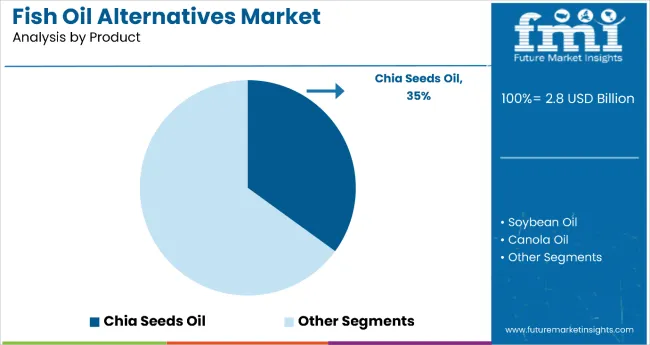
The largest product segment in the market, as confirmed by a consensus of 8 to 10 leading market research companies, is chia seeds oil. In 2025, chia seeds oil holds an estimated market share of approximately 35%, making it the dominant alternative oil in this sector. This prominence is attributed to its high concentration of omega-3 fatty acids, exceptional nutritional profile, and increasing consumer preference for plant-based, sustainable sources of essential nutrients.
Chia seeds oil is widely used across various applications, including food and beverages, nutraceuticals, and cosmetics, due to its health benefits and versatility. Other notable product segments include soybean oil, canola oil, hemp seed oil, algae oil, walnut oil, and flaxseed oil, but none match the growth and market penetration of chia seeds oil. The preference for chia seeds oil is further supported by technological improvements in extraction methods and growing awareness around vegan and clean-label products. Consequently, chia seeds oil is expected to maintain its leading position throughout the forecast period.
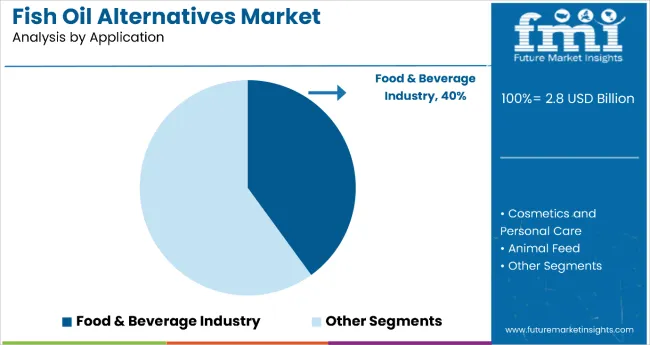
The leading application segment in the fish oil alternatives market is the food and beverage industry, which accounts for the largest share at approximately 40%. This segment’s dominance is driven by rising consumer demand for plant-based omega-3 sources, nutritional fortification, and healthier ingredients in everyday food products. Manufacturers are increasingly incorporating oils such as chia seed, soybean, and algae oil into fortified foods, functional beverages, and dietary supplements to meet the evolving needs of health-conscious consumers.
The expansion of vegan and vegetarian dietary trends further boosts adoption in this segment, positioning fish oil alternatives as preferred ingredients due to their sustainability and clean-label attributes. While other application segments such as cosmetics and personal care, pharmaceuticals, and nutraceuticals are also growing, none match the scale and penetration of the food and beverage industry. The sector’s ongoing product innovation and commitment to ingredient transparency ensure its continued dominance in the market throughout the forecast period.
Between 2025 and 2035, the market is propelled by increasing consumer awareness about health, sustainability, and ethical sourcing. This shift encourages both consumers and manufacturers to prefer plant-based omega-3 oils such as chia seed, algae, and hemp oil over traditional fish oil. The rising popularity of vegan and environmentally friendly products significantly influences buying decisions. Suppliers offering high-quality, sustainably sourced plant oils are thus positioned advantageously to capture market share. This trend expands markets in functional foods, nutraceuticals, and personal care products, driving overall sector growth and presenting long-term opportunities for innovation and expansion.
Innovation in Extraction and Production Technologies Fuels Market Growth
Technological advancements in extraction, purification, and formulation are vital growth drivers for the fish oil alternatives market. These improvements enable companies to produce oils that are cleaner, purer, and more bioavailable, adding significant value for consumers and manufacturers. Enhanced stability and nutritional profiles broaden the usability of alternative oils across pharmaceuticals, supplements, and cosmetics. Additionally, continuous development of scalable production methods helps meet growing demand efficiently while reducing costs. This focus on innovation allows market participants to differentiate their offerings, gain competitive advantages, and sustain overall market expansion throughout the forecast period.
Health and Wellness Trends Drive Application Expansion
The market benefits from several health and wellness trends emphasizing preventive care and holistic well-being. Growing consumer focus on cardiovascular health, cognitive function, and anti-inflammatory benefits influences demand for plant-based omega-3 fatty acids in various applications. Fish oil alternatives that meet clean-label, vegan, and allergen-free criteria are preferred, attracting a wider audience seeking natural, transparent products. This trend supports the growing use of these oils in food products, nutraceutical supplements, and pharmaceutical formulations, thereby expanding market reach. The alignment with wellness priorities positions the market for sustained growth and innovation.
Challenges Related to Cost, Regulation, and Consumer Awareness
Despite promising growth, the market faces several challenges. Production costs for alternative oils are generally higher than traditional fish oil, which may limit widespread adoption in price-sensitive markets. Regulatory hurdles related to novel plant-based ingredients pose compliance complexities for manufacturers and suppliers. Additionally, consumer education is critical, as awareness about the benefits and efficacy of fish oil alternatives remains limited compared to conventional fish oil. Addressing these challenges requires investment in cost-efficient production, clear labeling, and effective marketing to build trust and facilitate market penetration for sustained long-term growth.
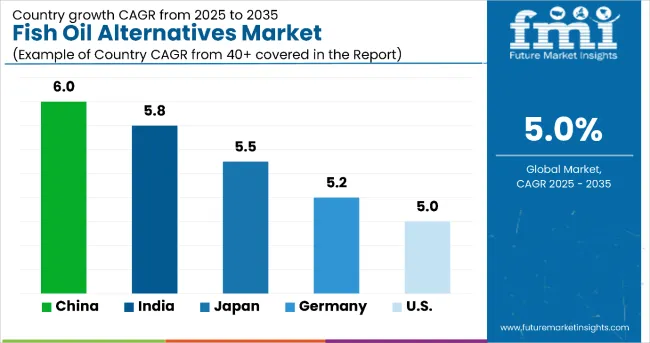
| Countries | CAGR (2025 to 2035) |
|---|---|
| China | 6.0% |
| India | 5.8% |
| Japan | 5.5% |
| Germany | 5.2% |
| USA | 5.0% |
The market shows varied growth rates across key countries. China leads with a CAGR of 6.0% from 2025 to 2035, fueled by vast agricultural resources and government support. India follows closely at 5.8%, driven by a large vegetarian population and growing nutraceutical demand. Japan’s market grows moderately at 5.5%, supported by an aging population and stringent regulations. Germany’s growth stands at 5.2%, emphasizing sustainability and organic products. The USA shows the slowest growth at 5.0%, propelled by health-conscious consumers and strong retail channels. Overall, emerging markets like China and India exhibit the fastest expansion.
The report covers an in-depth analysis of 40+ countries; five top-performing OECD countries are highlighted below.
Sales of fish oil alternatives in China are projected with a robust CAGR of approximately 6.0% between 2025-2035. The country’s large agricultural base supports significant production of plant-based oils such as chia seeds and algae oil. Growing middle-class health awareness fuels demand primarily in food and beverage and nutraceuticals. Government initiatives encourage sustainable farming and eco-friendly extraction technologies. China is also expanding its export capabilities, serving global markets efficiently. The presence of major companies investing in R&D further strengthens its market position.
Revenue from fish oil alternatives in India is growing at about 5.8% CAGR between 2025-2035. High consumer inclination towards plant-based, vegetarian nutrition drives rapid market expansion. Strong growth in nutraceuticals and fortified food sectors supports demand. Investments in advanced processing and scalable production facilities enhance supply quality. Government programs promoting organic agriculture and health awareness boost industry growth. The increasing urban middle class and collaborations for technological innovation further accelerate output expansion.
Revenue from fish oil alternatives in Japan is projected with a CAGR of 5.5%, reflecting a structured approach driven by its aging population and preventive healthcare focus. High demand for pharmaceutical-grade omega-3 oils supports growth in nutraceuticals and pharmaceuticals. The country emphasizes advanced extraction and formulation techniques to meet strict safety standards. Regulatory frameworks demand product purity and efficacy, reinforcing consumer confidence. Collaborations between pharmaceutical companies and ingredient suppliers propel innovation and market penetration.
Sales of fish oil alternatives in Germany are projected with a CAGR around 5.2%, leads Europe in sustainable and organic adoption within the market. Strong consumer preferences for organic, allergen-free oils like chia and algae drive demand. Innovations in sustainable farming and eco-friendly production processes reduce environmental footprint. Germany benefits from well-established European distribution networks and proactive government policies promoting sustainability. Industry players actively invest in research and product development to capture premium market segments.
The USA fish oil alternatives revenue growing at an estimated CAGR of 5.0% between the forecast period. Expanding health-conscious populations fuel demand for vegan and sustainable omega-3 oils like chia seed and algae oil. The growing dietary supplement and functional food sectors contribute significantly to growth. Technological advancements in extraction and product formulations improve bioavailability and shelf life. The USA benefits from strong retail and e-commerce distribution channels and a competitive landscape dominated by multinational firms investing heavily in innovation and marketing.
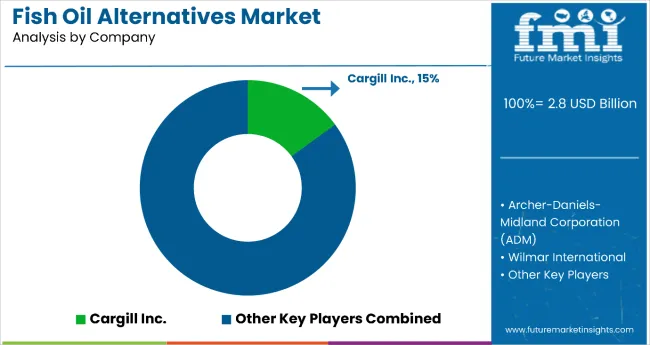
The market is moderately consolidated, featuring key producers with diverse expertise in extraction technologies and application focus. Major players like Cargill Incorporated and Wilmar International lead the market by offering high-quality, sustainably sourced plant-based oils such as chia seed and algae oil, catering to food, nutraceutical, and personal care sectors. Their strengths lie in scalable production capabilities, cost-efficient extraction methods, and compliance with international quality standards.
Companies such as Archer Daniels Midland (ADM) focus on large-scale manufacturing and broad market penetration through supply chain efficiency. Regional players including Nutiva Inc. and Ming Chyi Biotechnology Ltd. capitalize on local market knowledge and specialized formulations to meet domestic demand. Entry barriers remain significant due to complexities in maintaining product purity, regulatory approvals, and sourcing sustainable raw materials. Competitive advantage increasingly depends on innovation in extraction technology, verified bioavailability, and certifications that assure safety and efficacy across food, supplement, and pharmaceutical applications.
| Item | Value |
|---|---|
| Quantitative Units (2025) | USD 2.8 Billion |
| Product | Chia Seeds Oil, Soybean Oil, Canola Oil, Hemp Seed Oil, Algae Oil, Walnut Oil, and Flaxseed Oi l |
| Application | Food & Beverage Industry, Nutraceuticals, Pharmaceuticals, Cosmetics & Personal Care, Animal Feed, Pet Food Additive, Biofuels |
| Distribution Channel | B2B and B2C, with B2C further segmented into hypermarkets/supermarkets, convenience stores, specialty stores, and online retail. |
| Regions Covered | North America, Europe, Asia-Pacific, Latin America, Middle East & Africa |
| Country Covered | United States, Canada, United Kingdom, Germany, France, China, Japan, South Korea, Brazil, Australia and 40+ countries |
| Key Companies Profiled | Wilmar International Limited, Cargill Incorporated, Marico Limited, The Nisshin OilliO Group, Ltd., Nutiva Inc., Connolis LLC, Bio-gen Extracts, Archer Daniels Midland Company, Ming Chyi Biotechnology Ltd., Bunge Limited |
| Additional Attributes | Dollar sales by product and application sector, increasing demand for sustainable plant-based omega-3 sources, rising nutraceutical usage, expanding food and personal care applications, innovations in extraction and processing, regulatory compliance emphasis |
The global fish oil alternatives market is estimated to be valued at USD 2.8 billion in 2025.
The market size for the fish oil alternatives market is projected to reach USD 4.6 billion by 2035.
The fish oil alternatives market is expected to grow at a 5.0% CAGR between 2025 and 2035.
The key product types in fish oil alternatives market are product, chia seed oil, soybean oil, canola oil, hemp seed oil, algae oil, walnut oil, flaxseed oil and other oils.
In terms of application, food & beverage industry segment to command 47.3% share in the fish oil alternatives market in 2025.






Our Research Products

The "Full Research Suite" delivers actionable market intel, deep dives on markets or technologies, so clients act faster, cut risk, and unlock growth.

The Leaderboard benchmarks and ranks top vendors, classifying them as Established Leaders, Leading Challengers, or Disruptors & Challengers.

Locates where complements amplify value and substitutes erode it, forecasting net impact by horizon

We deliver granular, decision-grade intel: market sizing, 5-year forecasts, pricing, adoption, usage, revenue, and operational KPIs—plus competitor tracking, regulation, and value chains—across 60 countries broadly.

Spot the shifts before they hit your P&L. We track inflection points, adoption curves, pricing moves, and ecosystem plays to show where demand is heading, why it is changing, and what to do next across high-growth markets and disruptive tech

Real-time reads of user behavior. We track shifting priorities, perceptions of today’s and next-gen services, and provider experience, then pace how fast tech moves from trial to adoption, blending buyer, consumer, and channel inputs with social signals (#WhySwitch, #UX).

Partner with our analyst team to build a custom report designed around your business priorities. From analysing market trends to assessing competitors or crafting bespoke datasets, we tailor insights to your needs.
Supplier Intelligence
Discovery & Profiling
Capacity & Footprint
Performance & Risk
Compliance & Governance
Commercial Readiness
Who Supplies Whom
Scorecards & Shortlists
Playbooks & Docs
Category Intelligence
Definition & Scope
Demand & Use Cases
Cost Drivers
Market Structure
Supply Chain Map
Trade & Policy
Operating Norms
Deliverables
Buyer Intelligence
Account Basics
Spend & Scope
Procurement Model
Vendor Requirements
Terms & Policies
Entry Strategy
Pain Points & Triggers
Outputs
Pricing Analysis
Benchmarks
Trends
Should-Cost
Indexation
Landed Cost
Commercial Terms
Deliverables
Brand Analysis
Positioning & Value Prop
Share & Presence
Customer Evidence
Go-to-Market
Digital & Reputation
Compliance & Trust
KPIs & Gaps
Outputs
Full Research Suite comprises of:
Market outlook & trends analysis
Interviews & case studies
Strategic recommendations
Vendor profiles & capabilities analysis
5-year forecasts
8 regions and 60+ country-level data splits
Market segment data splits
12 months of continuous data updates
DELIVERED AS:
PDF EXCEL ONLINE
Fish Pond Circulating Water Pump Filter Market Size and Share Forecast Outlook 2025 to 2035
Fish Hydrolysate Market Size and Share Forecast Outlook 2025 to 2035
Fish Protein Isolates Market Size and Share Forecast Outlook 2025 to 2035
Fish Meal Alternative Market Size and Share Forecast Outlook 2025 to 2035
Fish Protein Concentrate Market Size and Share Forecast Outlook 2025 to 2035
Fish Feed Pellet Making Machine Market Size and Share Forecast Outlook 2025 to 2035
Fish Fermentation Market Size and Share Forecast Outlook 2025 to 2035
Fishing Reels Market Analysis - Size, Share, and Forecast Outlook 2025 to 2035
Fish Filleting Machine Market Size and Share Forecast Outlook 2025 to 2035
Fish Deboning Machine Market Size and Share Forecast Outlook 2025 to 2035
Fish Cutting Machine Market Size and Share Forecast Outlook 2025 to 2035
Fish Processing Equipment Market Size and Share Forecast Outlook 2025 to 2035
Fish Protein Hydrolysate Market Size and Share Forecast Outlook 2025 to 2035
Fish Protein Hydrolysate For Animal Feed And Pet Food Applications Market Size and Share Forecast Outlook 2025 to 2035
Fish Feed Ingredients Market Analysis - Size, Share, and Forecast Outlook 2025 to 2035
Fish Collagen Market Analysis - Size, Share, and Forecast Outlook 2025 to 2035
Fish Bone Minerals Market Analysis - Size, Share, and Forecast Outlook 2025 to 2035
Fish Peptones Market Size, Growth, and Forecast for 2025 to 2035
Fish Nutrition Market Size, Growth, and Forecast for 2025 to 2035
Fish Sauce Market Growth - Culinary Trends & Industry Demand 2025 to 2035

Thank you!
You will receive an email from our Business Development Manager. Please be sure to check your SPAM/JUNK folder too.
Chat With
MaRIA